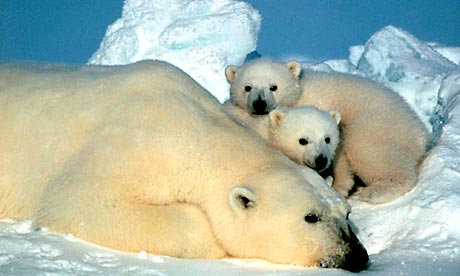The carbon catcher
Climate science pioneer Wallace Broecker thinks alternative energy would be a 'miracle', and Greenpeace have got it wrong. Instead we must store C02, he tells Ed Pilkington
- The Guardian,
- Saturday May 24 2008
Wallace Broecker's office looks at first glance what you might expect from the inner sanctum of one of the world's leading geoscientists and oceanographers. There is a giant map of the ocean floor strewn across a desk. A picture of a 19th-century gentleman with a magnificent beard hangs above the mantelpiece; I mistake him for Charles Darwin but am told he is the geologist and explorer, John Strong Newberry.
Closer inspection of the room reveals that it is anything but typical. There's no computer to be seen, while in one corner of the room is a life-sized photograph of Bob Hoskins in Who Framed Roger Rabbit. The other corner houses a 20ft fluffy snake, aqua blue with pink spots and a flashing red tongue. A sign around its head reads: "I am the climate beast and I am hungry."
Broecker, who is universally known as Wally and has done as much as anyone to bring the perils of climate change to the world's attention, sees climate as an animal capable of acting in unpredictable and violent ways. "If you're living with an angry beast, you shouldn't poke it with a sharp stick," he says.
He was among the first, in 1975, to sound the alarm on global warming even as many of his colleagues believed the Earth was cooling down. He can claim credit for the discovery of the conveyor belt flow of the oceans. He showed how the Earth's climate can change abruptly with brutal consequences. And he made seminal discoveries about the crucial links between climate cycles and the fluctuating concentration of atmospheric carbon dioxide.
It's an impressive resumé, all the more so as he accomplished it at the same time as raising six children with his wife, Grace, who died last year.
And, as the strange absence in his office attests, he did it all without the use of a computer. He writes in pencil, and relies on assistants at New York's Columbia University, his base for 55 years, to type up his manuscripts and print out his emails. "I suppose I'm lazy and I'm spoiled," Broecker says. "But it gives me the luxury of thinking. I still maintain that when scientists with all their computers can do better than I can, I'll step aside; but so far I can hold my own."
As the title of Broecker's new book - Fixing Climate: The Story of Climate Science and How to Stop Global Warming - suggests, he has now moved beyond explaining climate change in order to search for a solution. Broecker believes humanity is incapable of weaning itself from fossil fuels. C02 concentrations are already at 380 parts per million (ppm) - up from 280ppm before the industrial revolution, and are rising by more than 2ppm a year. "Some people say we can stop at 450ppm, but that's ludicrous," he says. "It will be hard, very hard, for us to stop at even 600ppm. And if we carry on doing what we are doing now - very little - we are going to get up to 800 or 900ppm. That's really a trip."
Alternative forms of energy, he argues, will fall short. Nuclear brings with it problems of disposal and the fear of weapons. Wind energy is simply too weak. Hydrogen fuel would require a whole new infrastructure to deliver it. Solar is probably the long-term answer but is unlikely to become cheap enough quickly enough to prevent disaster.
That leaves, he argues, a massive gap between the dramatic surge in energy use that will be seen over the next 30 years and the need to lower CO2 levels within the same timeframe. "A lot of people have unrealistic attitudes," he says. "If we put all these alternatives together, they say, we will have a solution. Maybe they are right. But what you see now is China and India adding a whole new element. Suddenly they are using energy like gangbusters, and a lot of it is coal. Too many people look at the rich nations and think we have to cut down, and of course we do, but boy, that's not going to solve the problem."
So we are all doomed? Broecker's book, co-authored with journalist Robert Kunzig, concedes that pessimism is a rational response. But it ends on a high, for Broecker has lent his name to, and to some degree staked his reputation on, a highly controversial new technology that claims to offer a way out of man-made disaster. "We've got to figure out a way to keep the world from being overheated," he says. "If you can't stop more and more C02 being pumped into the atmosphere then we need a safety net capable of solving the whole problem." Broecker, together with a team he helped assemble, believes he has done just that. Their new machine, prosaically called a "scrubber", is intended to suck CO2 out of the open air and capture it, ready to be neutralised or stored where it can no longer cause damage.
Broecker introduced a fellow scientist at Columbia, Klaus Lackner, whom he describes as the "best brain I have ever met", to an engineer called Allen Wright. Together they drew up a prototype scrubbing machine that they say can draw CO2 out of the air - a technique mastered in enclosed spaces such as submarines but never before achieved in the open atmosphere, and generally regarded by scientists and policy makers as impossible. Broecker then introduced the pair to his great friend, the late mail-order clothing tycoon Gary Comer. Comer was a keen sailor who had become aware of the melting ice sheets after he sailed his 151ft yacht straight through the Northwest Passage virtually unencumbered by ice. Alarmed, he tracked down Broecker, flying in his private jet to see him in 2002. The result was a $5m donation that helped pay for the scrubber.
The unlikely arrival of this energetic, can-do businessman had a profound impact on Broecker. The scientist had been contemplating retirement, having survived cancer and heart disease. I ask him whether his illness had any bearing on his approach to global warming. "I'm not very philosophical about things like that," he says. "I had a bone tumour, I was walking on crutches, having night sweats. They gave me chemo and within two weeks it just blew the tumour off. My attitude was: if I survive I survive, if I die I die. I was fatalistic."
Surgery to remove a tumour from his jaw in the 1980s left Broecker's face slightly lopsided, adding to an impression of eccentricity. With his wispy hair, twinkly eyes, and 1970s-style clothes, he comes across as an archetypal mad professor - proudly so. Recently he moved into a state-of-the-art new building in Lamont, Columbia's verdant outpost in New York state. He had to leave the rusty old laboratory he affectionately calls the Pigsty.
The new lab was paid for by Comer's foundation. Broecker's office sits directly over the main entrance, allowing him to pounce on anyone he wants to talk to as they come in - his preferred form of communication, rather than hated email. But the product of his collaboration with Comer that Broecker is most excited about these days is their new machine, stored in a laboratory in Tucson, Arizona. This is the scrubber that Comer paid for, Lackner conceived and Wright built. It deploys a secret new form of plastic which the team says attracts CO2 in a way that allows the gas to be captured, compressed and then safely deposited underground.
Critics regard the very suggestion that there is a way to take CO2 out of the air, reversing fossil-fuel pollution, as sacrilege. Greenpeace has accused the Lackner team of gross irresponsibility, on the grounds that they are condoning more combustion of oil and coal. Broecker is indignant at the suggestion.
"When Greenpeace says we shouldn't capture and bury CO2 because it encourages the use of coal, I say it's not that we are encouraging it. Desperate people who want energy are going to use the coal they have and there's no way in hell that we are going to stop them." But he stresses he doesn't see CO2 capture as a substitute for the search for an alternative source of energy. "If we found the magic bullet to make energy another way we would put this new technology on the shelf. But I happen to think it would take a miracle to find an alternative form of energy in time."
Broecker concedes that a meaningful attack on CO2 levels through scrubbing the air would be a gigantic task involving the whole planet. He points out that if all the CO2 that is likely to be pumped into the air over the next 20 years were captured and liquefied it would fill Lake Michigan. "Every mile you drive an ordinary American car, like the beat-up Toyota I drive, produces 1lb of CO2. That's 20,000lbs a year, just from my car."
In any case, whatever solution to the problem of global warming is preferred by the public and its leaders, it will require extraordinary political will to push it through, and at present that is wholly lacking. I ask him how big he thinks the gulf is between the challenge ahead and the political determination to face it. "Huge, huge," is his reply.
The three candidates for the White House have all campaigned around the issue of global warming, though none has yet approached him for advice. But Broecker is sceptical that the next president will move fast enough.
"It's easy to talk about tackling this in a campaign, because they don't have to face the financial pain. But when they get into office they will feel the reality - if they make it too painful they will be kicked out."
The climate is a beast, don't poke it. A superstitious person would swear blind that as we finish our conversation the snake at Broecker's feet slithered a little and shook its tongue. But this is science. That never happened.
· Fixing Climate: The Story of Climate Science - and How to Stop Global Warming, by Robert Kunzig and Wallace Broecker, is published by Profile Books on June 2. To order a copy for £9.99 go to guardian.co.uk/bookshop or call 0870 835 0875. Both authors are at the Guardian Hay Festival on May 31. Box office 0870 990 1299





